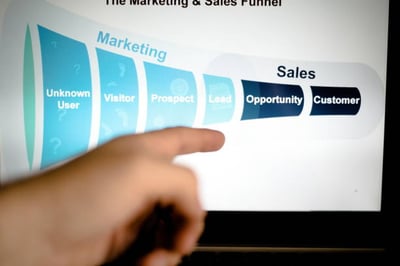March 31, 2020
 by Graham Anderson / March 31, 2020
by Graham Anderson / March 31, 2020
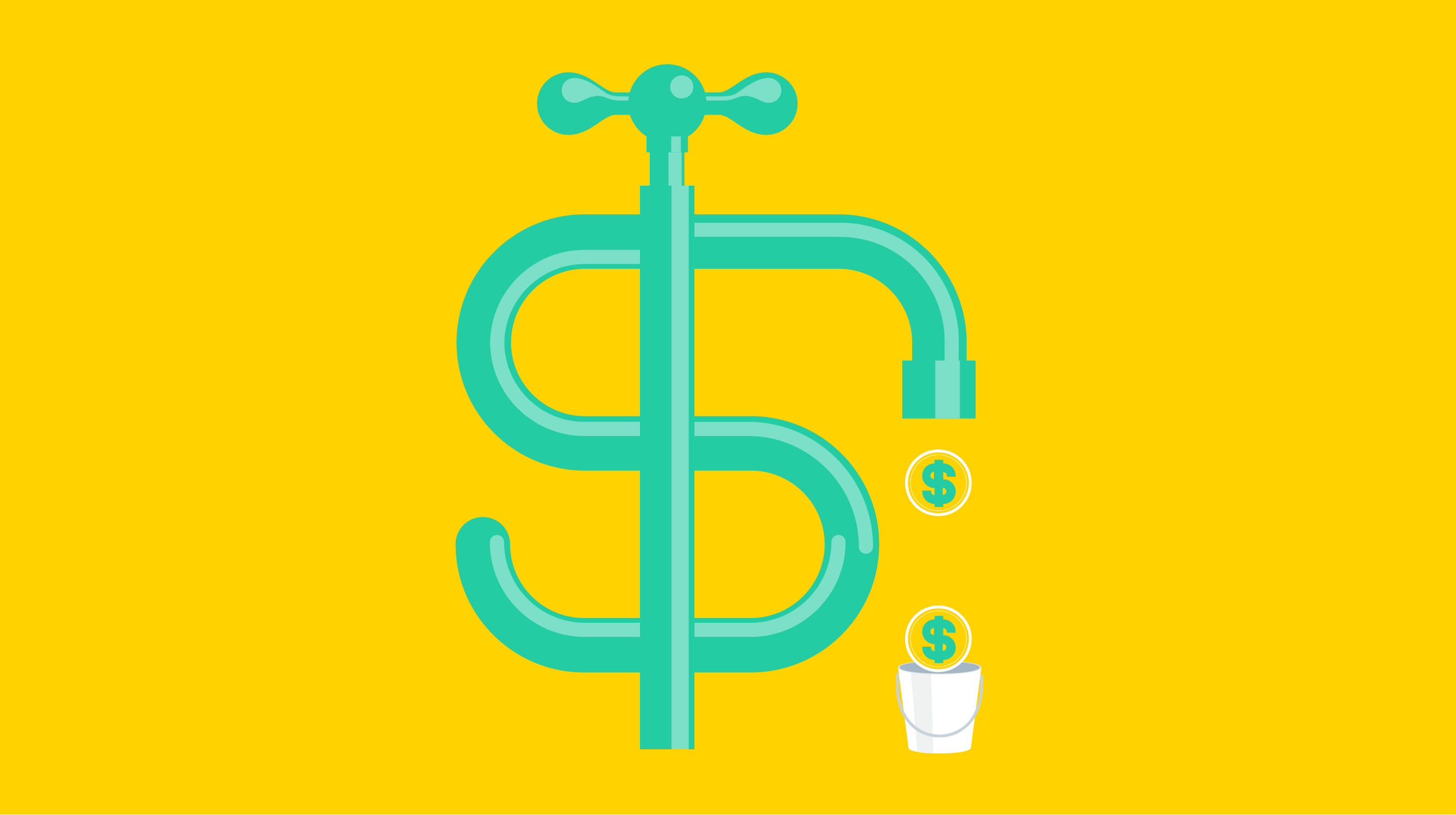
Visible progress can be an effective motivator.
People who work hard love to see how their efforts are impacting their end goal. Not only does it prove that the time and energy dedicated to a task was worth it, but it also shows that attaining their goal is within arms reach.
The best way to visualize and track your progress in sales is with a sales pipeline.
A sales pipeline is a method businesses use to track the progress of their current deals so they can designate actions for the rep to take in each stage. The idea is that prospects will travel along a predetermined route as they convert from a lead to a paying customer.
A sales pipeline is used to describe the way your sales team and prospects interact. It’s a two-way street:
It’s important to note that on occasion, sales reps will use the word pipeline when referring to the dollar amount attached to the deals that are in progress as opposed to the stages of the pipeline. What they’re talking about is value, not the pipeline itself.
Although every company will have different stages of their sales process, as well as varying tried and true methods for getting their customers through each one successfully, there are certain key elements you will need to have for a successful sales pipeline.
Building a sales pipeline takes time, effort, and (usually) quite a few attempts before you get it right. You’ll want to discuss the various elements with other members of your sales team to make sure you’re taking every bit of their process into account. Also, your pipeline will grow and change as your business does, so you will need to regularly review it.
Here are the four steps in building a sales pipeline that could work for your business.
To define the stages of your sales pipeline, the best thing to do is take a deep dive into your buyer’s journey. It’s easy, and tempting, to simply look for a template online, but attempting to work with something that isn’t tailored to the way your company does business can lead to wasted time, resources and an ineffective pipeline.
Review the stages your customers go through when making a buying decision. Typically, this will include three steps: awareness, consideration, and decision.

With those stages in mind, think about how that plays into the actions of your selling process. It might look a little something like this:
As a prospect is in the awareness stage, it would be an ideal time for you to connect with them and qualify whether or not they’re a good fit for your business's solution. Then, once they enter the consideration phase, you can conduct a value demonstration and handle any objections they might present.
Finally, after they have made the decision to purchase your solution, you can close the deal and start making an effort to nurture that relationship.
To summarize, that would make the stages of your sales pipeline look like this:
Of course, it’s rarely that easy to get someone to convert from a lead to a customer. There are going to be some bumps in the road. However, once those are taken care of, the buyer journey will still end up looking something like that.
Another thing you must consider is timing. One reason businesses have sales pipelines is to estimate the amount of time their sales process will take.
Get a solid estimate of the amount of time a customer from a closed-won deal spends in each stage of your sales pipeline. Understanding these benchmarks will help when forecasting which deals are most likely to close, as well as picking out prospects that could use some more attention.
A great piece of advice at this point is to not overcomplicate things when you make your first draft. Start with the basics. Then, as you think of additional stages, you can fit them in where they’re most appropriate.
Once you have a rough idea of your pipeline stages, you need to figure out how to make it work for your conversion rates. Essentially, this stage includes determining how many people you need in each stage of your pipeline to reach your sales goals.
Here are the steps in identifying your pipeline size:
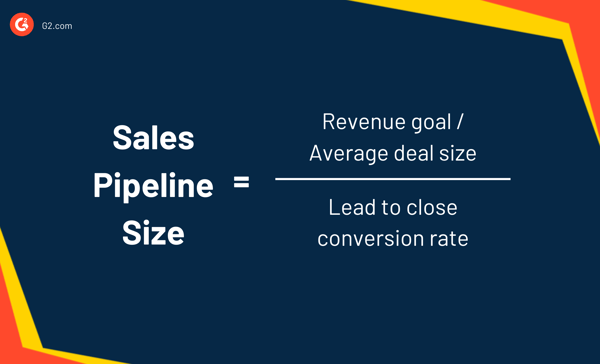
This final number will tell you how many customers you need to enter into your sales pipeline to reach your goals. Here’s an example:
Say your business has a revenue goal of $100,000 for March, an average deal size of $5,000, and a lead-to-close conversion rate of 10%. To reach that goal of $100,000 in revenue, your sales team would need to start with 200 leads in the pipeline.
Sales pipeline size = ($100,000 / $5,000) / .1 = 200
The reason being is that if you have 200 leads, and 10% of them convert, that would leave you with 20 closed-won deals. And since your average deal size is $5,000, and you have 20 deals, that would put you at your goal of $100,000 in revenue.
Essentially, this calculation tells you how many leads you need to start a certain time period with. This is important to know when striving towards goals for any new month, quarter, or year. If you don’t start with enough leads, it’s hard to make up for that deficit.
So now that you know what the stages of your sales pipeline are, it’s time to think about how your prospective customers will move through it.
How does your sales team know when a prospect has moved from being a lead to an interested potential buyer who is ready to hear a value demonstration? These transition points are usually triggered by your prospect and then carried out by your sales team.
Define the moments and customer actions that tell your sales team that a prospect has reached the point where they need to move from one sales stage to another. Pair them with corresponding activities for the rep to complete to ensure they keep moving along.
The customer will signal when they are ready to continue, but it’s the job of the sales rep to give them the information and resources they need to do so.
The final element of building your sales pipeline is making sure that your sales process fits nicely within it, and that they support each other. If your sales pipeline and process aren’t synchronized, your team will become disorganized and misled on the progress of deals.
If you realize that you’ve missed out a whole chunk of your sales process, don’t worry. Just scroll back up to the first step, add your new sales stage, and work your way back down.
Building a sales pipeline takes time and effort. Don’t be disheartened if you have to write a number of iterations. The important thing is that you get it right for your team and your prospective customers.
There are common sales metrics that concern your pipeline that are valuable for you to know. These metrics come in handy when reporting results, measuring your success, and forecasting future sales.
Here are seven metrics you will be using to assess the success of your sales pipeline.
A lead is a person that has expressed interest in your business, or someone who would reasonably be interested in your solution. Being a lead is the first identity that a customer will embody, and it’s crucial to make sure enough are entering the sales pipeline to support goals. Keep in mind that not every lead will convert into a customer.
Refer back to the sales pipeline size equation to calculate how many leads you need to reach your goals.
An opportunity is a qualified lead, which means they fit the persona of someone who would typically buy your business’ solution. Making sure you have enough opportunities is key for measuring the success of your pipeline. You need opportunities to make sales, plain and simple.
It’s important to track the conversion rate between each stage in your sales pipeline. This will offer insight into how well your sales reps are performing in particular areas.
Your team might be great at presenting value demonstrations, but struggle with getting enough leads to enter the pipeline. To ensure the pipeline is healthy as a whole, each part needs to be attended to.
Your win rate is also known as your lead-to-close ratio. Essentially, it shows how many leads you successfully converted into a customer, as well as the overall success of your sales pipeline, process, and team.
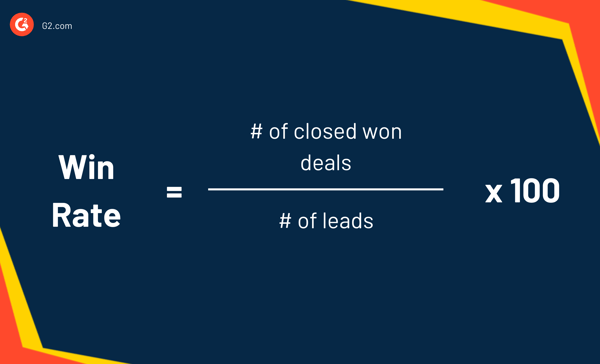
Regularly reviewing the win rate is crucial, but you also have to remember to pair it with the loss rate at each of the individual stages. You can use this to re-evaluate those calculations so they’re working for you even as your process and pipeline evolve.
Knowing how big the deals are at each of the stages in your pipeline (and what your averages are) will help you allocate resources for the production stage after the deal has been won, help you decide if you need to hire more salespeople, and inform business forecasting.
Your sales cycle length refers to the amount of time it takes to move someone through the entire sales pipeline. Essentially, how long does it take to close a deal?
Your average sales cycle length is an important metric to measure because it‘s a reflection of how efficiently you’re moving your customers through the pipeline. If a customer is sitting in the pipeline too long without any activity, it can affect the flow, focus of the team, and view of progress.
A fast-moving pipeline is a healthy pipeline.
Your sales velocity reveals how much money your business is making in a single day. Keeping an eye on how quickly deals are moving through your sales pipeline and comparing this to other metrics such as total value, number of touch points, and win/loss ratio will tell you how well your sales process is working.
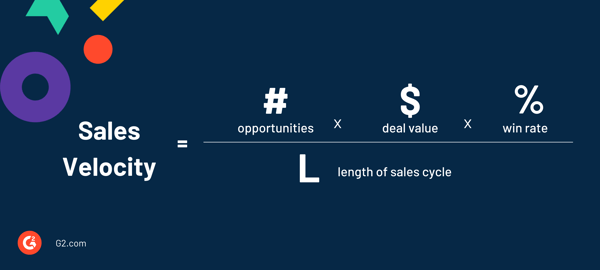
Selling is a lot of work. Even after you have established a sales pipeline that works for your business’ selling process, you need to make sure the pipeline is well managed. Problems will arise within your pipeline and in dealing with customers, but sales pipeline management strategies will ensure everything runs smoothly.
Here are some tips for managing your sales pipeline.
Don’t make your prospects chase you. You want them to know you value their business. Follow up with prospects that aren’t giving you definite answers. This way, you can either move them down the pipeline or remove them if they aren’t interested.
Using a CRM for your sales data enables you to access all the information you need regarding customers, automate sales processes, and easily access reports to give you the data you need. Why wouldn’t you use one?
It sounds heartless, but you need to think about the business at large sometimes. Don’t totally forget about all the others, but prioritize accounts that offer more value to the business. Keep the long term relationship in mind - the deal worth the most at this very moment might not be as valuable in the long run.
If someone loses interest, don’t run after them. It’s annoying and you’ll only antagonize them. It might hurt to see a potential customer go, but there comes a point when you have to take a step back and ask yourself an important and difficult question.
“Is this worth my time?”
Related: It’s possible that the reason you have so many dead leads on your hands is that you’re focusing on the wrong ones in the first place. G2 offers buyer intent data that can help you identify customers researching your business so you can target the right people and kiss dead leads goodbye.
Those sales pipeline metrics were mentioned for a reason. Be sure to keep track of those metrics to check in on your progress towards goals and pick up on where your pipeline is struggling. You can also compare metrics from different time periods to see where you’re improving and struggling more over time.
Never assume that the things that worked yesterday will work today. Things change, and you need to make sure your sales process and pipeline can adapt. Find areas in your pipeline where customers spend most of their time, and determine if there’s a way to make it more efficient.
Don’t rush your prospects, but don’t leave them waiting either. Make sure your cycle is as short and simple as it can be. Don’t overcomplicate the process, and be there to provide everything the customer might need, including content, knowledge-base articles, or how-to guides.
Once you’ve got your sales pipeline built and implemented, it’s inevitable that you’re going to make some mistakes. Let’s touch on some common pipeline pitfalls so you can avoid the setbacks of making them.
Spending too much time focusing on the tail end of your pipeline, closing deals, and letting the other stages fall away may feel like the right decision at the time. And you’ll probably bring in a lot of revenue.
But once those close, you’ll be left with nothing to follow up, no deals to close, and no revenue to generate. Make sure you’re always paying attention to prospects in all stages of your sales pipeline.
Hard data will be the first thing anyone will look at to determine if your sales pipeline, and business, is a success or failure. Make sure the pipeline is updated and metrics are a main focus.
If your team isn't filling in the details of their ongoing deals or opportunities, you aren’t getting the information you need.
It happens to everyone - a prospect you think was just about to close suddenly went with a competitor or just stopped returning your emails. When this happens, try not to dwell. You haven’t failed. These things happen, don’t beat yourself up about it. Focus that energy on those prospects and deals that you still have a chance of closing.
This goes back to that old adage of “bad data in, bad data out”— don’t let your sales pipeline become cluttered, full of duplicates, and just generally messy.
Keep your data tidy and it will work that much harder for you.
It’s too easy for a pipeline to start getting cluttered with what ends up being bad and unnecessary data. These are deals that aren’t going to go anywhere, have gone cold, or have out of date information on them.
Fixing this and preventing your pipeline from falling prey to the same issues in the future comes down to two things: admin tasks and paying attention to detail.
Here are a couple of ways to tackle those tasks.
If you’ve got an opportunity that has been sitting in a particular stage for longer than usual, it’s important to find out why. Are they waiting for a grant or a slow-to-respond executive? Consider taking them out of your normal pipeline and adding them to a new stage: on hold.
Or maybe they just need some extra attention? Maybe they need another meeting or to chat with someone more senior to allay their concerns. Whatever the case may be, it’s vital that you have a way to find these slower moving opportunities.
If a deal has truly gone cold, it’s sad, but as a business, you have to be realistic enough to know that it’s always a possibility.
Data segmentation is going to be key in your sales pipeline, so a good best practice would be to mark prospects that you are giving up on (after one final effort, of course), as such: lost - gone cold.
Remember to have a triggering activity that kicks it into that stage or status. Maybe you have an email that you would want to send out as a final attempt to connect (and remind them of your details). Or maybe it’s a final phone call. Whatever works best for you.
The salesperson’s nightmare: having to keep data up to date! Oh, the admin!
Being serious though, a prospect might tell you their phone number has changed, or they might contact you from a new email address, or maybe that you need to speak to a new project.
Either way, if data changes, make sure you record it in your CRM (or other management tool). Otherwise, you’ll end up losing out on deals because your sales team didn’t keep up with the admin tasks.
Your sales process is your sales team’s side of the pipeline. It includes the steps your sales reps need to take to successfully convert that lead into a buying customer.
Examples of these steps include prospecting, giving value demonstrations, and handling any objections the customer might present.
Your sales pipeline is a visual representation of your prospect moving through your sales process and ultimately becoming a customer. Wherever your customer lies in their journey, that’s where you place them in the pipeline. It’s meant to show progress and forecast the next steps for that particular customer.
To create a sales pipeline, you must first establish a sales process that aligns with your customers’ journeys.
Think of a sales pipeline as a bridge or link between your prospects’ world and your sales team’s office. It’s where the journey takes place.
A sales funnel is meant to show conversion between stages based on cohorts. For example, your sales funnel would represent the number of leads you converted into opportunities in a given period of time.
Sales forecasting is the long-term view of the sales funnel. It’s most often used by management to estimate how much revenue the sales team will be able to generate in the future.
These estimates are based on something known as a weighted amount — a percentage of an opportunity’s value based on where it’s in your pipeline. Deals in the latter stages of your pipeline are more likely to close, so their weighted amount will be higher.
Forecasting uses the funnel’s weighted amounts (and sometimes previous years’ sales data) to help plan for the coming months’ and years’ projects. It’s about being able to estimate the cash flow of your business.
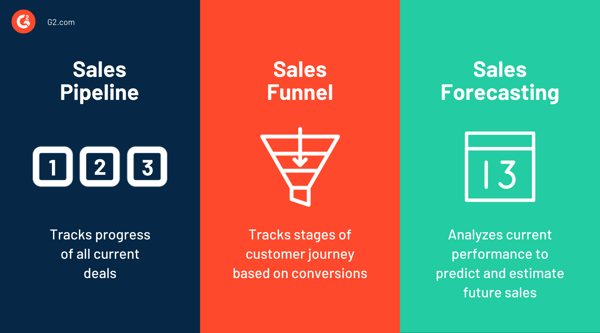
Your sales pipeline is there to tell you whether or not your selling efforts are cutting it for your business. The sales process can get complicated, and so much back and forth between you and your customers can get confusing, making you question where you stand with them.
Establishing a sales pipeline will not only answer that question - it will reveal your next move.
As your reps successfully move customers down the pipeline, you want to reward them, right? Learn how to create a sales compensation plan that will please and motivate your team of sellers.
Before Graham got his start in the tech industry as part of Apple's UK Mac launch team, he was a professional drummer. He has been involved in the tech industry, primarily software development, for over 20 years. He founded OpenCRM in 2005 and is a System Architect as well as Managing Director.
A robust sales pipeline is at the heart of any fast-growing business.
 by Yash Vardhan
by Yash Vardhan
If there’s one thing I’ve learned working closely with sales teams, it’s this: gut instinct...
 by Soundarya Jayaraman
by Soundarya Jayaraman
My days were 36 hours when I was a part of a sales team.
.png) by Shreya Mattoo
by Shreya Mattoo
A robust sales pipeline is at the heart of any fast-growing business.
 by Yash Vardhan
by Yash Vardhan
If there’s one thing I’ve learned working closely with sales teams, it’s this: gut instinct...
 by Soundarya Jayaraman
by Soundarya Jayaraman
